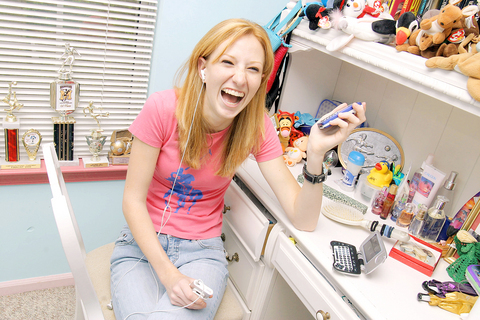Last Christmas, Kristi Stangeland, a mother of two who lives in Hastings-on-Hudson, New York, made a grievous mistake: She bought her 14-year-old daughter, Erika Hinman, a shiny new MP3 player. But it was the wrong MP3 player.
"I tried to get away with getting her an MP3 player that was US$100 cheaper," Stangeland explained sheepishly.
"I was in the biggest dog box," she said, recalling Erika's crestfallen response. "She went to school, and everyone else had got an iPod for Christmas. It was like, `How come everyone else got one, and you couldn't buy me an iPod?' So we got one for her birthday two months later."

PHOTO: NY TIMES
Although parents have long struggled with their teenagers' desire to own the newest, coolest stuff, these days the battle has reached a new dimension. While teenagers once coveted US$100 sneakers and jeans (arguably necessities because, after all, they are clothes), the must-have items now -- iPods, cell phones with cameras, and portable DVD players -- are high-tech, constantly in need of upgrade and can cost up to US$500 each. These items, which teenagers say they must have to maintain their place in the social pecking order, are increasingly out of reach for most high school students, who are less likely these days to hold part-time jobs.
Researchers who study child behavior call this pressure "nag factor" or "pester power," and often use it to describe how young children, in whom advertising has planted a desire for junk food or toys, lobby their parents. Now the same pestering is reaching a fever pitch among teenagers, who crave an ever-expanding collection of high-tech items they can't possibly afford.
The upshot is that more parents are finding themselves in the situation that Stangeland faced: footing the bill so their children can maintain social face.
"It's a good reason never to grow up," said Cary Silvers, vice president for consumer trends at Roper Youth Report, a nationwide poll from NOP World, a consumer research firm, which recently found that 18 percent of boys aged 13 to 17 surveyed owned an MP3 player, and that 37 percent owned a DVD player. But only 10 percent of the teenagers had a job, and on average they netted only US$29 a week.
"The bottom line," Silvers said, "is the majority of their purchases are subsidized by parents and other family members like grandparents."
It is a vortex of contemporary social currents: Teenagers' longing outstrips their ability to satisfy it and collides with most parents' hope to teach restraint and fiscal responsibility. The issue is not just pressing for the middle class. Teenagers of all economic groups are exposed to the same advertising and social pressures, and families rich and poor struggle with how and how much to provide.
"Parents are told by psychologists that they should pick their battles with their kids," said Susan Linn, a psychologist at Harvard Medical School and Judge Baker Children's Center.
"But should they pick the iPod battle, the cell phone battle or the R-rated movie battle? I think parents are really struggling. There are more things for kids to nag them for, and because these things are expensive, they're likely to go for their parents," she said.
It is no secret that Apple's sleek iPod, costing US$99 to US$449, has become, to the US teenager, a de rigueur fashion item, not just a handy gadget.
"The iPod blew up the category," said Sharon Lee , a founder of Look-Look Inc, a company in Hollywood that tracks teenage consumer behavior. Not only did Apple's MP3 player "open a category that just didn't exist before," she said; it changed the way teenagers thought about gadgetry.
But the iPod is not the only object of great desire.
"In the last couple of years, there seems to be a shift in badge items," said Michael Wood, a vice president at Teenage Research Unlimited in Northbrook, Illinois, which tracks youth buying patterns for more than 150 companies. "Whereas in the past it was an expensive pair of shoes or jeans -- something on the fashion side -- today the excitement and buzz is really around technology."
Tina Wells, who founded Buzz Marketing Group, another youth market researcher, based in New York, said the shift in priorities was particularly evident when she polled teenagers about what they coveted as gifts during the last holiday season. In 2003, Wells said, "it was all fashion."
"Everyone wanted a gift certificate to the Gap," she said. Last year, however, 63 percent listed a tech item as their gift of choice.
Three-quarters of teenagers between 15 and 17 now have mobile phones, up from 57 percent last year, according to the Roper Youth Report, an annual poll. Parents pay for 74 percent of the wireless plans in question, according to another survey, by the NOP World mKids Study, perhaps reflecting the fact that many parents see cell phones as a practical and safety item.
"Pretty much everybody has a cell phone, and iPods, probably one out of three people," said Greg Becker, 15, of Owings Mills, Maryland.
"It's huge. I get on my bus in the morning, everybody is listening to little white earbuds. Last year it was only a couple of kids. For guys, having an Xbox or a PS2, all the guys have those. Off the top of my head I can think of one person who doesn't," he said.
"Kids are very good, and relentless, at getting what they want, from the day they're born," said Susan Beacham, a parent of two girls, 13 and 11, in Lake Bluff, Illinois, and a founder of Money Savvy Generation, a group that coaches parents and children in fiscal responsibility.
"The pester power comes with them saying: `Mom, Madeline has one, so does Mira. Every time I want to call you, I have to borrow theirs,'" Beacham said. "It comes in the form of questioning your parenting. `Why wouldn't you keep us safe?' Then it goes to the iPod. `I've earned it, I excel in school, in excel in sports, why wouldn't you give it to me?"'
Last Christmas her 13-year-old pleaded that an iPod Mini was "a piece of the uniform," and Beacham told her she could have one as her one gift, instead of several smaller ones. But when her 11-year-old also wanted one, she was told she had to wait another year.
"For the parent, you're faced with the pressure but you do not have to do it," she said. "Your child will truly survive."

AIR SUPPORT: The Ministry of National Defense thanked the US for the delivery, adding that it was an indicator of the White House’s commitment to the Taiwan Relations Act Deputy Minister of National Defense Po Horng-huei (柏鴻輝) and Representative to the US Alexander Yui on Friday attended a delivery ceremony for the first of Taiwan’s long-awaited 66 F-16C/D Block 70 jets at a Lockheed Martin Corp factory in Greenville, South Carolina. “We are so proud to be the global home of the F-16 and to support Taiwan’s air defense capabilities,” US Representative William Timmons wrote on X, alongside a photograph of Taiwanese and US officials at the event. The F-16C/D Block 70 jets Taiwan ordered have the same capabilities as aircraft that had been upgraded to F-16Vs. The batch of Lockheed Martin

GRIDLOCK: The National Fire Agency’s Special Search and Rescue team is on standby to travel to the countries to help out with the rescue effort A powerful earthquake rocked Myanmar and neighboring Thailand yesterday, killing at least three people in Bangkok and burying dozens when a high-rise building under construction collapsed. Footage shared on social media from Myanmar’s second-largest city showed widespread destruction, raising fears that many were trapped under the rubble or killed. The magnitude 7.7 earthquake, with an epicenter near Mandalay in Myanmar, struck at midday and was followed by a strong magnitude 6.4 aftershock. The extent of death, injury and destruction — especially in Myanmar, which is embroiled in a civil war and where information is tightly controlled at the best of times —

China's military today said it began joint army, navy and rocket force exercises around Taiwan to "serve as a stern warning and powerful deterrent against Taiwanese independence," calling President William Lai (賴清德) a "parasite." The exercises come after Lai called Beijing a "foreign hostile force" last month. More than 10 Chinese military ships approached close to Taiwan's 24 nautical mile (44.4km) contiguous zone this morning and Taiwan sent its own warships to respond, two senior Taiwanese officials said. Taiwan has not yet detected any live fire by the Chinese military so far, one of the officials said. The drills took place after US Secretary

THUGGISH BEHAVIOR: Encouraging people to report independence supporters is another intimidation tactic that threatens cross-strait peace, the state department said China setting up an online system for reporting “Taiwanese independence” advocates is an “irresponsible and reprehensible” act, a US government spokesperson said on Friday. “China’s call for private individuals to report on alleged ‘persecution or suppression’ by supposed ‘Taiwan independence henchmen and accomplices’ is irresponsible and reprehensible,” an unnamed US Department of State spokesperson told the Central News Agency in an e-mail. The move is part of Beijing’s “intimidation campaign” against Taiwan and its supporters, and is “threatening free speech around the world, destabilizing the Indo-Pacific region, and deliberately eroding the cross-strait status quo,” the spokesperson said. The Chinese Communist Party’s “threats